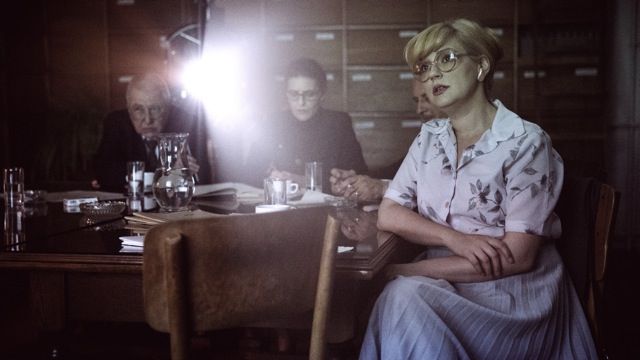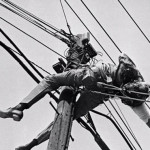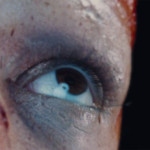HOT DOCS 2015: CHUCK NORRIS VS. COMMUNISM
With Toronto’s esteemed Hot Docs Documentary Film Festival kicking into full gear this weekend – including the Premiere of Ilinca Calugareanu’s CHUCK NORRIS VS. COMMUNISM tomorrow night (April 25, 9:30pm – details HERE) – I am reposting an interview I did with director Calugareanu and producer Mara Adina during my FANGO days. At the time, the film was still in the Indiegogo stage and pressed with raising funds for the animated segments of this intriguing film about how the illegal smuggling of 80s action movies into communist Romania helped create the uprising that would eventually topple the regime. Well tomorrow, we get to see how it all turned out – but in the meantime, here’s the interview to whet your appetite!
++++
Please note this article first appeared on Fangoria.com in April 2013 and in some cases refers to past events.
++++
There is a synchronicitous plethora of films either just released or in the works about the 80s VHS explosion – from Josh Johnson and Carolee Mitchell’s SXSW hit REWIND THIS to Mike Malloy’s PLASTIC MOVIES REWOUND, Dan Kinem and Levi Peretic’s ADJUST YOUR TRACKING and Mark Hartley’s Cannon Films-focused ELECTRIC BOOGALOO – but while there’s no doubt that all these films document a game-changing media revolution whose practical and nostalgic effects linger on today, how many of their directors can claim that VHS actually helped to overthrow a totalitarian regime in their country? Ilinca Calugareanu can.
Calugareanu’s CHUCK NORRIS VS. COMMUNISM, currently in post-production, shows how the arrival of VHS in 1980s Romania didn’t just signal a media revolution, it became the instrument of a very real mass protest against a totalitarian regime that resulted in its demise. The glut of action films, horror films, erotic thrillers and teen comedies that accompanied the home video explosion in Western countries became a symbol of freedom to those under Communist rule, and Irina Nistor, who secretly dubbed all the voices on these films for local dissemination through pirated video tapes, literally became the unifying voice of defiance for her Romanian fans. CHUCK NORRIS VS. COMMUNISM tells the tale of Nistor, her enigmatic employer Mr. Zamfir, and the films whose hilariously bloated American propagandizing created unlikely heroes to those on the other side of the Iron Curtain.
FANGORIA chatted with director Ilinca Calugareanu and Producer Mara Adina (sisters who grew up in Romania and are now based out of the UK) about the film, its protagonists and political implications, and their Indiegogo Campaign.
++++
FANGORIA: How far along are you guys?
ILINCA CALUGAREANU: We’ve been editing for a couple of months, since January, and the plan is to have a rough cut by June or July and finish it by the end of the year. And we have a lot of animation so that will take about three months to do.
FANG: What made you decide to go with animation?
CALUGAREANU: Well the whole story, as you know, has happened already, it’s all set in the 80s. So I guess the natural choice would have been reconstructions but I’m really not comfortable with that. They can be kind of heavy and old, and unflexible. And animation on the other hand just gives you a world of possibilities. The other reason is that our main character Zamfir, the guy who started the whole VHS operation in Romania, he’s a businessman, this is the guy who brought the money in, made everything work. And Zamfir is a very mysterious guy, he likes to keep this aura of unknown around him, and for a long time people though Irina did everything, and didn’t know about the guy in the shadows. And I thought, if he wants to keep this aura around him, we should respect that and do it as well, and so although he’s our main character, he’s going to be completely animated. It reveals a lot of who he is, and I think that’s going to be one of the biggest challenges of the film, to create that presence. Because he’s an amazing character, he’s almost surreal, the things he’s done and been though –
MARA ADINA: And the way people talk about him is unbelievable. Everyone speaks of him as though he’s this overlord –
CALUGAREANU: Yeah, there’s that huge respect, but there’s also fear, so there’s exactly that mixture of feelings around him.
FANG: How did everyone know who the woman was who did the voice? Were there credits on the tapes?
CALUGAREANU: No, no, people didn’t know. Until the revolution no one knew. The thing is Irina has such a memorable voice because it’s so high-pitched, you can’t mistake it. So I think that created a brand in itself. And the funny thing is – and we’re gonna have a bit in the film with this – they imagined her in different ways. From a neurotic middle-aged woman doing this in her basement whilst cooking, and other people were giving her fantastic features like one of those tracksuit-wearing karate-kicking heroes. There’s this whole world of Irina shapes and forms that people build around her. And it was only during the revolution that her face was on TV, and that was when people connected the two. She was working for the national TV station all that time, she was doing translations for the censorship committee. So on the one side she was working for the state – not buying into the censorship, she was actually crushed by seeing how films were cut and reduced to nothing because they were ‘dangerous’ – and then afterwards she would go to Zamfir and work for him through the night – her record is ten films in a row. At first sight.
FANG: So it was just live, the first time watching the film she would just dub as she went?
CALUGAREANU: Yeah. So it was a mad, adrenalin-filled job. Her biggest worry was missing if someone died. And she had a big dictionary, and sometimes you can hear it on the tape, as she’s flipping through trying to find some words.
FANG: So did you grow up watching these?
CALUGAREANU: Yeah. I think all the people of my generation and older did. But it was the only thing, because TV was only two hours a day, and it was all about the dictator visiting factories, pointing at things, how glorious the regime was. We had five minutes of cartoons on the Sunday special program.
FANG: What kind of cartoons?
CALUGAREANU: Well it was all chopped-down, they would take bits of LADY AND THE TRAMP –
FANG: So American cartoons, not local cartoons?
CALUGAREANU: Well there were a few people in the TV station who were trying to push things, trying to wrap them up into this thing where they were not dangerous, but it was always chopped and didn’t make any sense. But all the kids, you can imagine – Sunday comes: “Cartoons!”
FANG: How did everybody get VCRs?
CALUGAREANU: That was another adventure. You couldn’t get them in shops. But in Romania they started these very exclusive shops for tourists, because they were trying to boost tourism, and you could get a VCR there if you had a foreign passport. So you had to find someone with a foreign passport and they could get it for you. And the other strategy was to have people bring them illegally over the border. And if you got one you kind of had to hide it, because you never knew who your neighbours were and who would tell the secret police. Because in the 80s it got so bad, studies say that a third of the population were informers for the secret police. So there was this general paranoia, and as kids our parents would say “don’t say this in school, never say you have a VCR, never say you saw something.” Because you never knew who would tell and then you’d end up in the files and then trouble would start.
So getting VCRs was difficult and they cost around the price of a car or a flat, so it was impossible for most people to get it. So what happened is a few more enterprising people started little business from this where they had one or two VCRs and some tapes and rent them out. Each night it would go with a VCR, a color TV and five tapes all wrapped in a blanket. And that would cost about a third of the monthly wage, so people would put money together and spend the whole night watching films, about 10 or 20 people in one flat. And it had this magical feeling, like you’d stepped into a completely different world, and you had the excitement of doing something illegal, but also the contact with the West, with the outside world. We saw how people in another world lived. And that’s going to be one of the important things in the film, is that for a lot of people, these films – beyond the actual entertainment, as because most of them were action films, Chuck Norris, Van Damme, Bruce Lee – a lot of people were watching them just to see cars in America, bigger streets, bigger houses, swimming pools, or just how people behaved when they were free. Obviously these films didn’t represent normality as they were pro-American exaggerations, but people watching wanted to see how normal people behaved, how freedom works, how you can fulfill yourself rather than the state. I think that had a lot to do with getting people out into the streets during the revolution. I think Zamfir says it the best, he realized that these tapes were working at a level much deeper than just entertainment. And he said that from his point of view they played a part in triggering the revolution, that people were in the streets because they knew there was a different life out there, and they knew that from films.
FANG: How’s it going to work with all the rights to the film clips?
CALUGAREANU: Well that’s why our budget is the way it is, and why it’s a struggle to get there. [PLUG: remember you can help them get there by supporting their Indiegogo campaign HERE]
FANG: Do you know yet if you’re able to get a lot of the clips through fair use?
ADINA: In some territories we can, but in some countries you can’t. Probably in America we will be able to, but we’ll have to pay to use things in certain territories. And if it goes to broadcast sometimes they have deals with the companies.
CALUGAREANU: The film wouldn’t work without the clips. But for me, it’s also a film about the medium, about VHS, and the picture, and the blur. And the fact that these tapes were copied maybe ten or more times over. So there’s some tapes we have where you can barely see anything, beyond black and white, and so people are just imagining what they see.
ADINA: Do you think the quality of the tapes influenced why everybody has different memories of certain scenes, since they couldn’t see some of it? That’s occurred to me, because in the interviews, quite a lot of these iconic scenes, people have a different recollection of how the scene was set up.
CALUGAREANU: Oh yeah, I think it’s a combination of that, and the way memory works. A lot of the guys in the film, they’re in love with the technology, they’ve still kept their VCR.
ADINA: And they still have manual rewinders.
CALUGAREANU: Yeah, the rewinders were big and they made noise and the tape would roll funny. And we’ve been very lucky [that some people have kept everything]. Zamfir got rid of all his tapes around 1992, because he’s businessman and he could see things were going in another direction. He didn’t want to keep the tapes because he wasn’t emotionally attached to them at all, but one of his friends – who calls him “Mr Zamfir” even though they grew up together – he kept all of them. He said that until he dies, they’ll be there.
We actually spoke to James Bruner who was the writer of some of the MISSING IN ACTION films, and INVASION USA – which is just a brilliant title – and he had no idea the films were going past the Iron Curtain and what it meant for people. And he said he got goosebumps. We had a skype interview and he was so overwhelmed.
FANG: Well especially when you’re a writer or director like that, the mainstream establishment in the states dismisses your work as being unimportant. And a lot of times it takes a generation or two before you can start to see how those things really were important. I mean in the early 70s all the horror films were addressing the effects of the Vietnam War, which we all know now, but at the time people just thought horror films were stupid, and not critical, and not saying anything. And then by the time you got to the 80s people realized how much criticism of the war was implicit in those films.
ADINA: I think that’s why I fell in love with this story. As a filmmaker you always have this idea that you may think is ridiculous, that films can actually change the world and make the world a better place. But I do believe it. This story looks at those films that we dismiss so easily and yet they had such a lasting effect, and they still do. It’s proof.
++++
You have three chances to see CHUCK NORRIS VS. COMMUNISM at Hot Docs: Sat April 25 – 9:30pm / Mon April 27 – 4pm / Thurs April 30 – 4pm – details HERE)

 April 24, 2015
April 24, 2015  No Comments
No Comments







